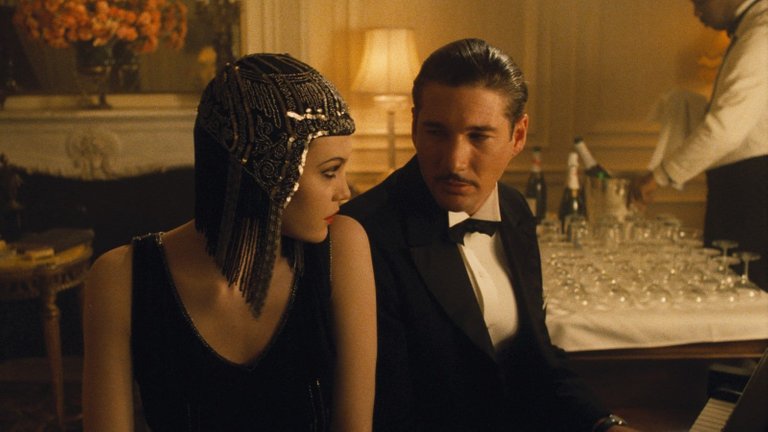Film Review: The Cotton Club (1984)

In early 1970s famous producer Robert Evans and famous director Francis Ford Coppola worked on The Godfather, gangster epic that would ultimately become one of the biggest hits of the time and maintain the reputation of the one of the best and the most influential films ever made. A decade later those two grand figures of New Hollywood cooperated on The Cotton Club, another gangster epic that would ultimately become of the most notorious flops in Hollywood’s history.
The film is inspired by the eponymous book by African American historian James Haskins, which had been dedicated to Cotton Club, famous Harlem nightspot where many great black musicians and entertainers in 1920s and 1930s began their career and which was popular among New York’s business, political and show business elite, as well as prominent figures of organised crime. There are two loosely connected plots that revolve around the club and which begin in 1928. Michael “Dixie” Dwyer (played by Richard Gere) is a white cornet player and aspiring jazz musician who likes to play with blacks. One evening he saves the life of notorious Jewish gangster Dutch Schultz (played by James Remar) and, as a sign of gratitude, gangster employs him as gopher, while Dixie’s brother Vincent (played by Nicolas Cage) joins Schultz’s organisation. Some of Dixie’s duties involves chaperoning Schutz’s young girlfriend Vera Cicero (played by Diane Lane) and Dixie, against his better judgment, falls in love with her. Thankfully, Owney Madden (played by Bob Hoskins), Irish mobster and influential owner of Cotton Club, offer way out for Dixie by arranging casting in Hollywood, where he would play character inspired by Schultz. In the meantime, two brothers - Delbert “Sandman” Williams (played by Gregory Hines) and Clayton “Clay” Williams (played by Maurice Hines) – work hard for a chance to perform as tap dancing duo in Cotton Club. Their relationship gets strained when Delbert decides to go solo. Sandman falls in love with singer Lila Rose Oliver (played by Lonette McKee), but she rejects her advances in fear that he would discover her secret about mixed racial ancestry and thwart attempts to escape racial segregation by passing as white.
The Cotton Club became infamous even before the premiere, thanks to long and extremely difficult production that was marked by quarrels between producers, many which would escalate in spectacular lawsuits and, in one particularly nasty case, even a murder. Robert Evans, who had originally wanted to direct, had to leave reins to Coppola who somehow managed to inflate already overblown budget to the sum which is today estimated to be between 47 and 65 million US$, incredibly high sum at the time. This made The Cotton Club one of the first films to be compared to the catastrophic flop of Heaven’s Gate, but in the end this film evaded the worst of that sorry fate due to slightly better box office results and much kinder reception among critics, many of them still in awe of its legendary director.
Coppola actually deserves some credit for preventing this film from turning into complete mess. While he apparently couldn’t put budget under control, at least he made sure that some of it became visible when it mattered the most – mostly in elaborate, spectacular and likeable dance-and-song numbers which show great painstaking effort in recreating legendary performances of distant past, as well as great care in finding costumes, sets and props to recreate Prohibition-era New York. Coppola is, however, less fortunate with the script he co-wrote with William Kennedy. There are two major plots that actually don’t connect well and actually work against each other. Plot dealing with Sandman is supposed to be more interesting, because he deals with rising community which is still struggling with institutional racism. It is, however, overshadowed by plot dealing with Dixie (character actually inspired by real life Classic Hollywood star George Raft), which provides more opportunity for shootings, stabbings, killings and all other cliched activities we are supposed to see in gangster epic. Richard Gere, apparently thrilled to show his real life skills of an accomplished cornet player, embraces his role with his usual enthusiasm, but his performance only makes flaws in characterisation and bad dialogue more visible. Young Diane Lane is wasted in forgettable role of gun moll, same as young Nicolas Cage in a role of brother who shows too much enthusiasm for his new gangster career. James Remar, with all his skill, can’t overcome cliches of psychopathic monster like Schultz. The best acting performance was, however, provided by Bob Hoskins, who plays character very much like the one played in The Long Good Friday, but with much more warmth and humour. Hoskins is especially good in scenes with his soft-spoken and towering partner Frenchie (played by Fred Gwynne), and it is shame that the script hasn’t focused solely on those two. In many ways, flaws of The Cotton Club are similar to those in 54 and Gangs of New York, two films with fascinating subjects that seemed to be too challenging for scriptwriters. Unlike those films, Coppola’s film delivered just enough author’s skill for the experience not to be utterly disappointing.
RATING: 5/10 (++)
Blog in Croatian https://draxblog.com
Blog in English https://draxreview.wordpress.com/
Leofinance blog https://leofinance.io/@drax.leo
Cent profile https://beta.cent.co/@drax
Minds profile https://www.minds.com/drax_rp_nc
Uptrennd profile https://www.uptrennd.com/user/MTYzNA
Hiveonboard: https://hiveonboard.com?ref=drax
Rising Star game: https://www.risingstargame.com?referrer=drax
1Inch: https://1inch.exchange/#/r/0x83823d8CCB74F828148258BB4457642124b1328e
BTC donations: 1EWxiMiP6iiG9rger3NuUSd6HByaxQWafG
ETH donations: 0xB305F144323b99e6f8b1d66f5D7DE78B498C32A7

https://twitter.com/draxblog/status/1459789731340988422
The rewards earned on this comment will go directly to the person sharing the post on Twitter as long as they are registered with @poshtoken. Sign up at https://hiveposh.com.